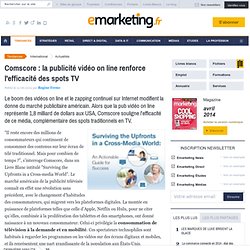

Comscore : la publicité vidéo on line renforce l'efficacité des spots TV. "Il reste encore des millions de consommateurs qui continuent de consommer des contenus sur leur écran de télé traditionnel.

Mais pour combien de temps ? ", s’interroge Comscore, dans un Livre Blanc intitulé "Surviving the Upfronts in a Cross-media World". Le marché américain de la publicité télévisée connaît en effet une révolution sans précédent, avec le changement d’habitudes des consommateurs, qui migrent vers les plateformes digitales. La montée en puissance de plateformes telles que celle d’Apple, Netflix ou Hulu, pour ne citer qu’elles, combinée à la prolifération des tablettes et des smartphones, ont donné naissance à un nouveau consommateur.
Celui-ci privilégie la consommation de télévision à la demande et en mobilité. Toutes ces mutations constituent de nouveaux défis pour les annonceurs et leurs agences. Vidéo : 180 millions de consommateurs aux États-Unis Premier chiffre incontournable. Le potentiel publicitaire des vidéos est encore sous-exploité. Les 10 premiers groupes Internet français dans le monde. Comprendre le Web chinois pour s'y lancer. Les Seniors sur Internet et les Réseaux Sociaux [infographie] Pourquoi la publicité sur mobile ne décolle pas (encore) Meet The Connected Reader - FigaroMedias - avril2012. 49pc of smartphone owners have watched a product video: study. Comparing Mobile Ad Effectiveness in US, UK, Germany and Italy. According to new research from Nielsen, tablet and smartphone owners in Germany, Italy and the U.K. are more likely than American device owners to make a purchase online via PC after viewing an ad on their tablet or smartphone.
Meanwhile, Italian device owners are the most likely to click on an ad to seek out further information on a product advertised on their tablet or smartphone. Americans are the least likely to make a purchase on their smartphone after viewing an ad. Finally, U.S. tablet owners are more likely to click on a mobile ad or search for more information after viewing a mobile ad than U.S. smartphone owners. Additional insights on mobile consumers can be found in Nielsen and NM Incite’s new U.S. Digital Consumer Report. Study: Cloud Computing will Create 14 Million New Jobs by 2015. The future for cloud service providers is very bright, at least if a new report (PDF) from research firm IDC is to be believed.

Commissioned by software giant Microsoft (which obviously also offers a range of cloud solutions), the study claims spending on public and private IT cloud services will generate nearly 14 million new jobs worldwide by 2015. See infographic at the bottom of this post or click here for a larger version. IDC also found that “IT innovation created by cloud computing” could produce $1.1 trillion a year in new revenues, although this forecast is about as vague as they come.
But hey, there’s a ‘trillion’ in there folks! According to IDC/Microsoft, shifting to cloud services could cut costs for companies and help create 1.2 million jobs by the end of 2015 in North America alone. More than 50 percent of those 14 million new jobs by 2015 will accrue to small and medium-sized businesses, IDC says. Study: Our engagement with brands based on pleasure - Research. Researchers surveyed UK consumers for the report.

"With brands all effectively competing for the same pound, we carried out this research to identify whether there was a way to measure brand enrichment that would be universal across brand categories, providing a long-term platform for brands to overcome consumer editing. That's what the eight dimensions do," said John Crowther, Managing Partner, Creston Unlimited.
"Using these dimensions through our brand measurement tool CUBE (Creston Unlimited Brand Enrichment), brands can see how well, or badly, both they and their competitors enrich consumers' lives and use this knowledge to create better differentiation and stronger engagement. The differences in women compared to men, and also between consumers at different lifestages and income levels, is something that brands need to understand and react to if they want to be relevant to today's consumer. " Some interesting findings from the study include: